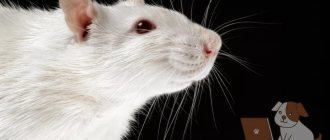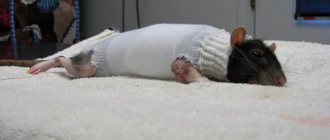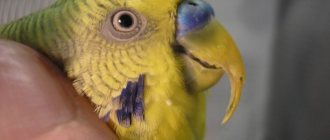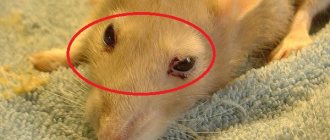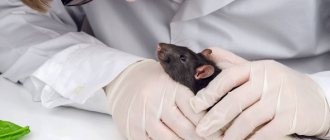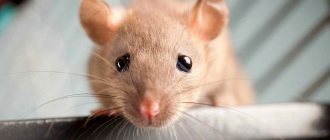What is it, what are the symptoms
In simple words, an abscess is an inflammation of tissue with the formation of a purulent sac. Pathology develops against the background of damage to the skin with the subsequent addition of pathogenic microflora. At first, the abscess may be quite invisible, especially under thick fur. However, over time, the lump grows and can be observed with the naked eye. The disease in decorative rats is characterized by the following symptoms:
- the appearance of a round bump above the skin;
- peeling and redness of the skin in the affected area;
- decreased vitality, apathy;
- increased anxiety;
- refusal to eat.
In some situations - if the animal has a strong immune system, as well as when an abscess forms in the subcutaneous fat, the tumor may simply burst out on its own over time. And then the pet can be put back on its feet at home.
Externally, abscesses in decorative rats are very similar to cancerous tumors. Therefore, it is better not to engage in self-diagnosis, but to have your pet checked at a veterinary clinic. Perhaps the situation is much more serious than it seems at first glance.
But if purulent inflammation has affected deeper tissues and moves inside the body, you cannot do without the help of a veterinarian. The pet will have to be taken to the doctor as soon as possible before complications begin. This includes blood poisoning, which can lead to death.
Main features
A timely detected subcutaneous abscess on a rodent's body will help save the life of a pet.
This disease can be recognized by the following signs:
- the rat’s behavior changes - it becomes lethargic, sleepy, and inactive;
- First, at the site of abscess formation, the skin turns red, later swelling occurs;
- the skin on the abscess becomes thinner and becomes covered with scabs;
- When opened, the resulting inflamed capsule is filled with yellow or green pus, emitting a rotten smell.
Causes of abscess
The main reason for the development of an abscess in a decorative rat is the presence of an infectious process. Pathogenic microflora enters the body in the following ways:
- With the development of infectious diseases of internal organs (for example, mycoplasmosis). Moreover, a pet can become infected both from sick cage neighbors and from the owner. There are many known cases of ornamental rats becoming infected with staphylococcus from humans.
- For any damage to the skin - abrasions, scratches, scratches, small wounds. Such damage can result from careless play, fights with other pets, aggressive grooming, or scratching due to allergies.
- When kept in unsanitary conditions. The rat's immunity rapidly deteriorates, and the animal is unable to resist the attack of pathogenic microorganisms.
- After hypothermia or being in a draft. If the animal has a cold, typical signs of ARVI appear along with inflammation.
Only a veterinarian can name the exact cause after carrying out the necessary diagnostic measures. In any case, treatment of the disease must be started as soon as possible, regardless of the nature of its origin.
Diagnosis of peritonsillar abscess
Diagnosis of the disease begins with pharyngoscopy - examination of the pharynx. With a paratonsillar abscess, asymmetry of the pharynx and protrusion of the tonsil on the affected side are observed. To clarify the condition of the abscess and the extent of the inflammatory process, laryngoscopy can be used - examination of the larynx using a laryngoscope. The patient is examined in a sitting position: the patient tilts his head back a little, opens his mouth wide, sticking out his tongue. This allows the otolaryngologist to examine all areas of the throat. The doctor also conducts a detailed survey of the patient in order to identify the cause of the disease, the presence of chronic diseases, individual characteristics of the body, etc.
In some cases, specialists at the Yauza Clinical Hospital refer patients for additional examination using ultrasound and CT machines. To prescribe treatment, it may be necessary to conduct some laboratory tests (general clinical blood test, determination of the pathogen that caused the abscess and its sensitivity to antibiotics).
On what parts of the body can it appear?
Purely theoretically, an abscess can develop on any part of the body of a decorative rat. But most often tumors appear in the following places:
- on the paws;
- on the body - on the sides, on the stomach, on the back;
- in the mouth - the situation is complicated by problems with chewing and swallowing food; if the abscess is located next to a tooth, it may have to be pulled out during treatment;
- behind the ears;
- before our eyes;
- on the neck;
- in males in the area of the testes.
Abscesses in the neck area are considered the most dangerous. The fact is that there are many large blood and lymphatic vessels passing through there. Damage to them threatens the animal with sepsis and sudden death. Therefore, under no circumstances should lumps on the neck be opened at home. Such pathologies are treated only in a hospital setting.
Tumors in pet rats
Decorative rats are loyal and emotional rodents, not inferior in intelligence and affection to the owner to dogs and cats. Keeping these animals in comfortable home conditions does not protect them from cancer.
Tumors in rats are even more common than common pathologies of the respiratory organs and lead to death. Female domestic rodents are most susceptible to cancer.
What to do if you notice bumps on a rat?
It is necessary to show the animal to a specialist to clarify the diagnosis and promptly prescribe treatment.
A tumor is an abnormal growth of pathological tissue in the body. Neoplasms in rodents can affect any tissue of the body. A tumor in a domestic rat can be benign or malignant.
A benign tumor is characterized by the presence of a connective tissue capsule that delimits the tumor from adjacent tissues. Due to this structure, this type of tumor is easily removed surgically. As it develops, such a tumor does not form metastases in other organs and does not grow together with healthy tissues, like cancer cells.
The danger of benign tumors lies in the compression of organs; when they grow rapidly, they reach quite large sizes and deprive the rodent of the ability to move and eat. If lumps are found on the body, it is advisable to treat the rodent as soon as possible.
A malignant or cancerous tumor is characterized by rapid growth, the formation of metastases in various organs and tissues, and the ability to grow into healthy cells and degenerate them. Cancer in rats cannot be treated surgically; the pet is left to live out its life with decent care and feeding, or euthanasia is used to alleviate the animal’s suffering.
IMPORTANT!!! Benign tumors can be removed surgically; rodent cancer cannot be treated!!!
Causes of cancer in decorative rats
As a result of many studies, the following causes of neoplasms in domestic rats have been identified:
- use of a high content of fatty foods and products with dyes and preservatives in the pet’s diet;
-lack of necessary active physical activity of the animal;
-heredity;
-stress;
-mycoplasmosis;
-gene predisposition to cancer in females.
Most often, tumors in decorative rats occur at the age of two years. Neoplasms can be localized in various areas of the rodent’s body:
Breast tumor
Female rodents are genetically predisposed to the appearance of mammary gland tumors, although sometimes similar tumors occur in males. Most often these are fibroadenomas - benign tumors located on the abdomen, armpits and groin of the animal in the area where the glands are located. The owner, who often caresses the animal, notices a tumor on the rat’s stomach at the very early stage of its occurrence. At home, a mobile, tuberous swelling can be easily determined, which can be soft and flat, or compacted due to the growth of fibrous tissue. The lump under the skin is penetrated by a venous network; when palpated, it easily slips between the fingers, there is no swelling and firm fixation with the subcutaneous tissue. If the swelling grows tightly together with the surrounding tissues, there is a chance that the rodent will develop cancer. The nature of the neoplasm is confirmed only by histological examination.
Tumor in the neck
A tumor is often diagnosed in a rat on the neck, which to the touch is defined as a subcutaneous tubercle that easily rolls between the fingers or is tightly fixed in the tissues.
A lump on a rodent's neck may be an abscess , an inflamed lymph node, a tumor, or a severely enlarged thyroid gland. Differential diagnosis and the nature of therapy should be carried out by a specialist in a veterinary clinic.
Tumor on the side
A tumor on the side of a rat occurs when the tumor is localized in the lungs or abdominal cavity. The lump on the side is often large in size; you can feel the tubercle on the leg. In such cases, bright symptoms indicate an oncological disease in a rodent: lethargy, bloody discharge from the mouth, vagina, urethra and anus.
Tumor under the paw
Sometimes you can find a tumor under a rat's paw. The lump under the paw turns out to be an inflamed lymph node, a wen, or a breast tumor.
Tumor under the tail
A tumor under the tail of a rat indicates a neoplasm on the skin and subcutaneous tissue, which feel like dense tubercles on the genitals of animals. It is advisable to remove them urgently; females often experience relapses.
Tumor on the cheek
The tumor may appear on the pet’s cheek, in which case the owner notices that the rat’s cheek is swollen. Often the animal becomes aggressive. In the area where the cheek is swollen, a subcutaneous ball or hard bone tumor may be felt, most often this is a cancerous tumor - squamous cell carcinoma, which cannot be treated surgically.
A brain tumor
Quite often, animals are diagnosed with a benign tumor in the brain, which manifests itself with neurological symptoms: the animal loses coordination of movement, the rat lies with tense front legs extended and hind legs bent backward, joints do not bend. Such neoplasms are inoperable.
Bone tumor
Pet rats are also susceptible to malignant bone tumors called osteocarcomas. The neoplasms are localized on the bones of the limbs, skull and ribs, and as a result, as they grow, the pet completely loses motor activity. The owner can feel the characteristic thickenings in the bone tissue.
What should you be wary of?
An attentive owner should be alert and take the pet to a veterinary clinic for timely treatment if the following symptoms are detected:
- soft flat bumps or hard bumpy growths on the animal’s body;
- lethargy, loss of appetite and weight, exhaustion;
- the animal does not play, tries to hide;
- the fur is tousled, there are patches of baldness;
- the skin loses elasticity and scabs appear;
- increase or decrease in bowel movements and urination;
- bloody discharge from the mouth, urethra, vagina and anus;
- hernias;
- mucous membranes are colored gray.
The final diagnosis is made by a veterinarian after a general examination of the animal, laboratory tests of general and biochemical blood tests, and the nature of the tumor is determined histologically.
Treatment of tumor diseases
Treatment of cancer in decorative rats is carried out surgically. The conservative method using immunostimulants and hormonal medications that inhibit tumor growth does not guarantee a favorable outcome.
The operation is not used for cancerous tissue lesions with the formation of numerous metastases, tumors in the brain, severe exhaustion of the animal, age over 3-4 years, presence of concomitant serious diseases, in such cases the prognosis is questionable or unfavorable.
The outcome of the operation and the possibility of relapses depend on the stage of node formation and the timeliness of surgical treatment. Small tumor formations in the early stages are quite easily removed, the prognosis is guarded or favorable. A benign tumor should not be allowed to grow to enormous sizes and exhaust the animal. Often, a pet undergoes several operations when tumors are repeatedly detected.
IMPORTANT!!! The earlier a tumor is detected and treated, the greater the chance of saving and prolonging the life of a pet rat!
Postoperative care
Postoperative therapy for the pet is carried out at home under careful supervision of the rodent owner. On the first day, a heating pad is indicated; for this purpose, you can use bottles of warm water. The owner should not allow postoperative sutures to “lick”; for this, a special or homemade collar can be used. On the recommendation of a specialist, the owner independently treats the wound with antiseptic solutions at home or in a clinic and applies bandages with anti-inflammatory ointments. Monitoring the healing of the postoperative wound and removing sutures is carried out only by a veterinarian.
Prevention of cancer in rats
There are several ways to prevent the appearance of tumor formations in a pet rodent:
- The pet's diet should be varied and low in calories, with a reduced content of fats, which have a carcinogenic effect. It is necessary to exclude the consumption of animal products containing dyes and preservatives;
- If possible, you should try to purchase a pet from reputable breeders who, when breeding, select individuals that are resistant to the development of cancer;
- It is better to keep males at home; they are less susceptible to the appearance of various neoplasms.
Carefully examine your pet rodents; at the first manifestations of a fatal disease, do not waste time; show your pet to specialists for a speedy diagnosis and timely treatment. It is in your power to save the animal and prolong its life.
How to treat an abscess
To determine treatment tactics, you must contact your veterinarian. In most cases, the doctor will suggest simply opening the abscess surgically. The operation is performed under local anesthesia and takes no more than 15-20 minutes. If deep tissues are affected, the procedure may take 30-40 minutes and will require suturing.
In some situations, for example, when small superficial abscesses occur, it is possible to remove an abscess from a decorative rat at home. The main thing is to wait for the abscess to fully ripen. Maturation will be indicated by softening and darkening of the cone, as well as the appearance of a white head in its central part.
To speed up the maturation of an abscess in a rat, you can periodically apply an iodine mesh to the abscess or tie a piece of cut aloe leaf (cut to the cone) overnight.
To avoid complications, during the procedure you must strictly follow a simple algorithm:
- Wash your hands with soap and, if possible, wear medical gloves.
- Using nail scissors, trim the hair on the affected area. You can do it not at the root, it will cause discomfort to the pet. It is better to leave a small “hedgehog”.
- If there is a crust on the surface of the abscess, you will need to soften it first. To do this, you need to moisten a cotton pad in warm water and apply it to the problem area for 5-10 minutes.
- Apply pressure to the tumor using a smooth movement, moving from the periphery to the center. You can't press too hard. If the abscess is mature, its contents will come out easily.
- As the pus flows out of the wound, you will need to constantly wipe it off with a cotton pad soaked in hydrogen peroxide. The manipulation must be carried out until blood flows from the abscess without any admixture of pus.
- When the procedure is completed, the wound will need to be washed with a solution of Chlorhexidine, Betadine, water and saline. The resulting liquid should be poured into a regular syringe and the wound should be thoroughly washed. After which, gently blot the treated area with a sterile bandage.
At the end of the home “operation” you will need to lubricate the affected area with Oflomelid or Levomekol. To prevent the rat from licking the ointment and smearing surrounding objects, it is better to apply a bandage to the wound and secure it by putting a special postoperative blanket for rodents on the rodent. You can buy the product at a pet store or order it online.
It is worth noting that before opening the abscess, you will need to create a pleasant psychological atmosphere - calm the rat, stroke it, talk to it in a gentle voice, encourage it. If the animal is agitated and clearly nervous, it is better to postpone the procedure for at least a few hours.
Atheroma
A type of abscess - suppurating atheroma - video of an operation to open an abscess
At the stage of abscess formation, there is still the possibility of conservative treatment (antibiotics, physiotherapy, semi-alcohol dressings), which often results in cure. If a cavity with pus has formed, the only treatment is surgery. Under anesthesia or local anesthesia, the abscess is opened, pus flows out, after which the dead tissue is excised as completely as possible, the wound is washed and drained. After the operation, dressings are required (daily or every other day). The wound healing period is 10 - 20 days (depending on the size, depth and other factors. With extensive phlegmon, skin grafting may be required.
Caring for your rat after surgery
Opening the abscess is half the battle. The pet faces a rehabilitation period of 7-10 days ahead. At this stage, the owner must pay maximum attention to his pet. In order for the rat to recover as quickly as possible, the following measures will be required:
- Transplanting a small patient into a separate cage. This is necessary so that healthy relatives do not injure the fluffy during outdoor games. It is better to replace the usual filler with a disposable diaper. It is much easier for a weakened animal to move on such bedding. In addition, it will perfectly absorb exudate.
- Installation of feeders and drinking bowls in free access for the animal. The main thing is that the pet does not have to stretch and be in an uncomfortable position when wanting a snack or drink.
- Thorough cleaning of the cage. The exudate and residual pus released from the wound have a rather unpleasant odor. Therefore, you will need to change the bedding every day and, as necessary, wash the feeders, drinkers and other items located in the cage. This will help avoid re-infection.
- Daily treatment of the wound with an antiseptic. For example, Octenisept, Chlorhexidine, Miramistin.
- Introduction of foods containing probiotics into the daily menu. Apples, yogurt, and kefir will help normalize the intestinal microflora.
- If the apartment is cool, it is recommended to periodically place plastic bottles filled with warm water (but not boiling water) in the cage.
If your pet has received stitches, you may need to take them to the veterinarian to have them removed. However, in most cases, veterinarians suture rats using special absorbable threads.
Clinic of the disease
Purulent inflammation of the paratonsil tissue usually appears 3-5 days after a sore throat or exacerbation of tonsillitis. When the body weakens, this process can accelerate up to one day. Symptoms of the disease are:
- spasm of the masticatory muscles (trismus - the patient cannot open his mouth);
- severe sore throat that gets worse when swallowing;
- nasal voice;
- increased body temperature, sometimes up to 39-40 ° C;
- weakness and general malaise;
- headache;
- enlargement of the cervical and submandibular lymph nodes;
- the appearance of bad breath;
- pain in the neck when turning the head.
If the purulent abscess is large, the patient may experience breathing problems and shortness of breath.
Disease prevention
Abscess in rodents is a rather unpleasant disease that can cause adverse health consequences. Therefore, it is better not to rely on fate and from the first days of the pet’s appearance in the house, start preventing the disease. The following measures will help to avoid the appearance of ulcers:
- Regular examinations of your pet to ensure the integrity of the skin. Even small wounds or scratches require antiseptic treatment.
- Keeping the rat in proper sanitary conditions means regular cleaning of the cage, daily washing of feeders and drinkers, monthly disinfection.
- Protecting your pet from hypothermia. In the winter season, it is better to move the cage with the rat to another room for ventilation. Also, after bathing, you need to thoroughly dry the fur of the fluffy with a towel.
You will also need to remove all objects with sharp corners from the cage so that the pet does not accidentally get hurt. A rat can scratch its paw even on too coarse litter.
An owner who knows what an abscess in rats is and its main symptoms will be able to help his pet in the shortest possible time. The main thing is not to delay your visit to the veterinary clinic and completely trust the specialist.
Aftercare
Opening an abscess for a decorative rat is a serious operation that requires further care for the animal’s rapid recovery.
It is as follows:
- antiseptics can be used no more than once a day;
- isolate the sick rodent from other pets;
- provide him with adequate nutrition and plenty of fluids to restore strength, and also introduce probiotics into the diet to normalize the intestinal microflora after taking antibiotics;
- clean the cage with the rat every day, avoiding any unpleasant odor in it.
Also learn how to identify and treat mycoplasmosis in a rat.
Diagnostics of PTA
When contacting the medical otorhinolaryngology department, a detailed medical history will be collected. You will be asked questions regarding your health status. To clarify the clinical picture and choose the right treatment tactics, the ENT doctor will perform an examination, conduct a pharyngoscopy - an optical examination of the pharynx and tonsils, analyze your complaints, and refer you for laboratory tests.
culture for aerobic and anaerobic bacteria, if carried out
To clarify the diagnosis, imaging studies may be prescribed:
- Ultrasound;
- radiography;
- CT scan.
Causes of PTA
The disease rarely occurs independently and is often a complication of purulent tonsillitis or chronic tonsillitis. It develops when pathogenic flora penetrates the tissues of the palatine tonsils. The inflammatory process is provoked by:
- bacterial lesions against the background of Staphylococcus aureus, streptococci, Escherichia coli, Haemophilus influenzae, Klebsiella. A throat abscess occurs when a sore throat worsens. In some cases, the disease can develop without a previous infection of the pharynx with blockage of the salivary glands. Often paratonsillitis or paratonsillar abscess is preceded by acute tonsillopharyngitis;
- dental diseases. These include periostitis of the alveolar processes, gingivitis, caries, etc. They often cause peritonsillar abscess in children;
- injuries. The disease occurs through contact. Violation of the mucous membrane provokes infection of the area.
